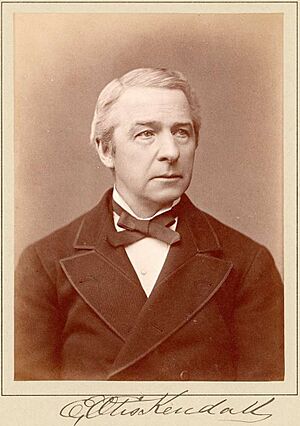Ezra Otis Kendall facts for kids
Quick facts for kids
Ezra Otis Kendall
|
|
|---|---|
 |
|
| Born | May 17, 1818 |
| Died | January 5, 1899 (aged 80) |
Ezra Otis Kendall (1818–1899) was an important American professor. He was also an astronomer and a mathematician. He is remembered for his work in uranography, which is like making maps of the stars and planets.
Ezra Otis Kendall was born on May 17, 1818. His hometown was Wilmington, Massachusetts. His parents were Ezra Kendall and Susanna Cook Walker. His mother had ancestors who came to America on the famous ship, the Mayflower. These ancestors were Francis Cooke and Stephen Hopkins.
In 1835, when he was 17, Ezra moved to Philadelphia. There, he studied mathematics with his half-brother, Sears Cook Walker.
Contents
A Career in Science and Teaching
Ezra Kendall started his teaching career early.
Teaching at Central High School
In 1838, Ezra Kendall became a professor. He taught mathematics and astronomy. This was at Central High School in Philadelphia. He also became the director of the school's observatory. An observatory is a place where scientists watch the stars.
Joining Important Societies
In 1842, he was chosen to be a member of the American Philosophical Society. This is a very old and respected group of thinkers and scientists. Later, he even became a vice-president of this society.
Professor at the University of Pennsylvania
In 1855, Ezra Kendall became a professor at the University of Pennsylvania. He taught mathematics and astronomy there too. He continued to rise in his career. In 1883, he became the vice-provost. This means he was a high-ranking leader at the university. He was also the dean of the college faculty.
Honors and Later Life
For all his scientific work, the University of Pennsylvania gave him a special degree. In 1888, he received an honorary Doctor of Laws, or LL.D., degree. Ezra Otis Kendall passed away on January 5, 1899. He died in Philadelphia and is buried there.
Works
Ezra Otis Kendall was known for his contributions to science. His work in uranography helped people understand the stars better.

